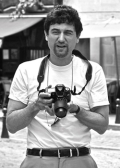 E-mail address: berlinert@uncw.edu
E-mail address: berlinert@uncw.edu
Home institution: University of North Carolina Wilmington
Academic position: Professor of Film Studies, University of North Carolina Wilmington, László Országh Distinguished Chair in American Studies, Eötvös Loránd University
Areas of research: film aesthetics; film narration;
American cinema; cognitive and neoformalist film theories.
Title of the presentation: On the Perception of Continuity
in Mainstream Cinema
Most important Publications
Book:
- Hollywood Incoherent: Narration in Seventies Cinema. Austin: University of Texas Press, 2010.
Articles:
- Hollywood Storytelling and Aesthetic Pleasure. Psychocinematics: The Aesthetic Science of Movies. Ed. Arthur Shimamura. London and New York: Oxford UP, forthcoming 2012.
- The Illusion of Continuity: Active Perception and the Classical Editing System. (with Dale J. Cohen) Journal of Film and Video 63.1 (2011): 44-63.
- Visual Absurdity in Raging Bull. Martin Scorsese?s ?Raging Bull?: A Cambridge Film Handbook. Ed. Kevin Hayes. New York: Cambridge UP, 2005. 41-68.
- The Sounds of Silence: Songs in Hollywood Films since the 1960s. (with Philip Furia) Style 36.1 (2002): 19-35.
- The Pleasures of Disappointment: Sequels and The Godfather, Part II. Journal of Film and Video, 53.2-3 (2001): 107-123.
- The Genre Film as Booby Trap: 1970s Genre Bending and The French Connection. Cinema Journal 40.3 (2001): 25-46.
- Hollywood Movie Dialogue and the ?Real Realism? of John Cassavetes. Film Quarterly 52.3 (1999): 2-16.
Title of the presentation
On the Perception of Continuity in Mainstream Cinema
Abstract
This paper proposes a holistic model of how the human perceptual system extracts coherence from discontinuous cinematic images edited according to classical continuity principles. Rooted in the current understanding of the human perceptual and cognitive systems, the paper?s model of spatial continuity lays out the cognitive basis of mainstream editing conventions. Synthesizing the available research in psychology and film studies, the presentation explains how mainstream editing devices exploit and accommodate the processes and limitations of our perceptual system in order to stimulate the perception of spatial continuity.
The series of images produced through mainstream editing devices are similar to those experienced in everyday life in that both are non-continuous (images come upon our senses in a fragmented way), follow similar patterning (mainstream movie images follow patterns that people regularly perceive in their everyday experience), and obey the same logic (the progression of images adhere to many of the same principles). Because of these similarities, the same perceptual systems that create the illusion of continuity in real world perception also create the illusion of continuity in mainstream cinema.Stitching together the fragmentary images generated by real-world perception or mainstream editing, the perceiver constructs a ?mental model? of coherent space.
The proposed model of spatial continuity explains how cinema spectators perceive continuity when viewing cinema?s fragmentary images, how mainstream editing devices facilitate the perception of continuity, and how filmmakers can create coherent spaces in movies without fully specifying on-screen space with shots or continuous camera movement. Finally, the model of spatial continuity offers tools and predictions for analyzing films and making films.
